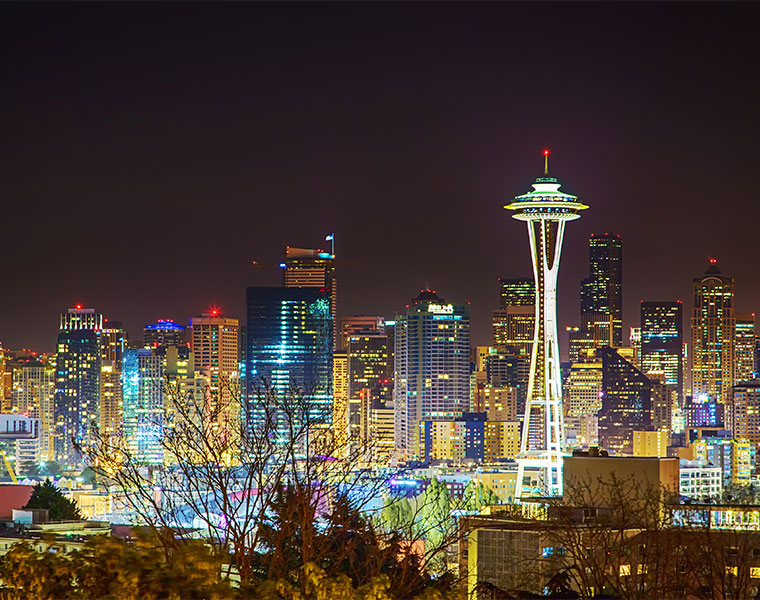By Ashlei Williams
Just a decade ago, mainstream usage of LED technology did not extend far outside of entertainment and decoration. Today, it is a leading technology utilized across industries from automotive to medicine. In the world of electrical, it has become a leading technology for energy efficiency. The trend is carrying over into infrastructure as cities across the U.S. navigate how to create green environments.
Streetlight retrofit conversions have showcased how LED technology not only saves energy, but reduces costs as well. Cities including Los Angeles, New York and Seattle have become innovators in the space, showcasing how the technology improves lighting for everyone from the end users dealing with glare, to entities such as police departments looking for more defined lighting to do their jobs better.
The City of Seattle is nearing the end of its LED streetlight conversion project that began in 2009. The project began largely because the city’s luminaires were at or beyond the 25-year design life for high-pressure sodium (hps) fixtures. Outages and customer complaints had reached a tipping point. Knowing that they were facing a capital investment to replace all of the city’s lights, they focused on discovering other benefits that could come from the project. While researching LED technology, they realized that with its energy savings they could also achieve cost reductions.
To gauge success, the city, with formal boundaries including Seattle, Lake Forest Park, Shoreline, Tukwila, SeaTac, and Burien, performed pilot projects to refer to for research. The tests were performed with an energy consumption reduction of 40 percent set as the goal. New LED technology for drivers and chips hit the market during this time, helping the city successfully achieve a 42 percent reduction in energy during the pilots. Through the pilots, the city also figured out how to reduce the harshness of the lighting, getting the color temperature down to 4,000 Kelvin.
The city gained approval for funding from the Seattle City Council and $1 million in funding through a federal grant. In 2009, the retrofit project officially started with about 5,000 fixtures to be installed. The project management team included Steve Crume, Joint Use and Streetlight Engineering Manager; Carol Anderson, project manager; and, Jeff Pimentel, resident engineer. The primary manufacturers for the project were Leotek, Cree, and American Electric Lighting, and the primary lighting reps were Sea-Tac Lighting and Northwest Natural Lighting.
“We require each manufacturer to have a local sales representative,” Crume noted. “Typically, they will sign a contract with one that’s already established in the area and we will work through the local sales team.”
The project is two-part, with residential as the first focus of the project and arterial as the second. The residential part of the project was completed in 2013, and has achieved higher than expected public acceptance with the new LED technology.
“We did not know what to expect,” Crume explained. “Going into this we were expecting a 20 percent complaint rate, mainly because our only prior experience was when we changed from mercury vapor to high pressure sodium back in the early 70s. That was the complaint rate then. So, we prepared for that. But in actuality, our complaint rate has been less than 0.2 percent.”
As the residential part of the project has been underway, the city was simultaneously working on completing analyses and meeting criteria to begin arterial, which are required by Seattle Department of Transportation (SDOT). The arterial side of the project began in 2015 and is expected to be completed in 2018, along with any cleanup work that the city will be going back in to complete residentially.
According to a 2015 report from the Department of Energy, 10 percent of outdoor lighting in the U.S. is operating through LED and this trend will continue in the future. There is an opportunity for distributors to partner with manufacturers who are creating the latest and greatest of this technology, as well as the forward-thinking cities and municipalities that are using the technology.
“Distributors definitely have to be responsive to the utility’s needs. Including being our liaison with the manufacturer and making sure that the materials are delivered on time and at the best cost point,” Crume said.
To learn more about the LED wave taking over cities, start with The Department of Energy‘s newsletter, The Light Post. It presents the latest in best practices, specifications, trends, research, end user behaviors, and more as it relates to street lighting.
—
Specializing in multimedia storytelling, Ashlei Cooper has been creating content and strategizing storytelling for business, philanthropic, minority and academic audiences for a decade. She earned her master’s in Journalism from Northwestern University’s Medill School and bachelor’s in English from Spelman College. In 2016, she started her communications company, GJC Publicity LLC, focusing on copy writing, social media, and media relations. She resides in Seattle, Washington, where she spends her spare time tutoring with Best In Class Education, running, and checking out the local fine arts scene. Get in touch with her via phone 253-693-8711, email ashlei@gjcpuiblicity.com, or web www.gjcpublicity.com.
Tagged with lightED, Seattle, street lighting
